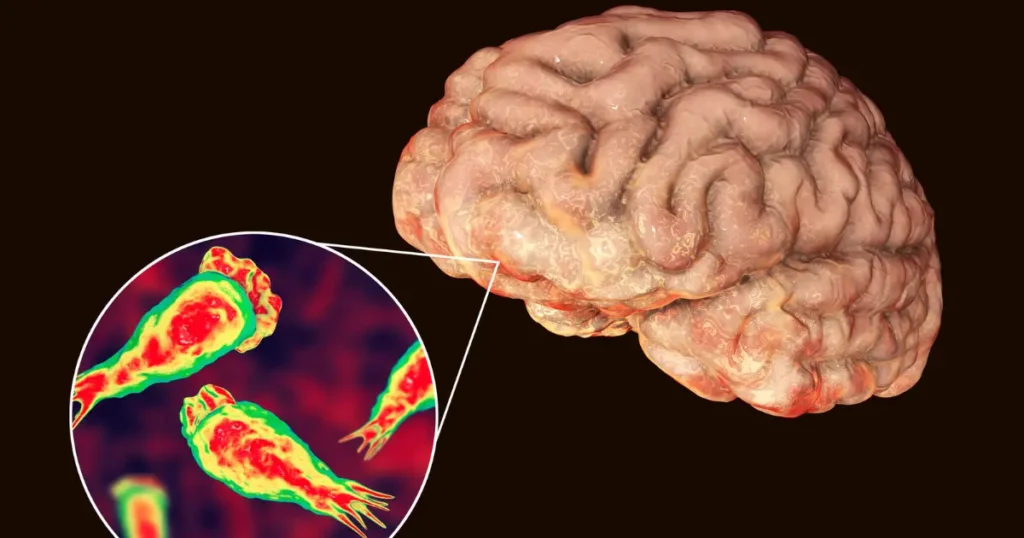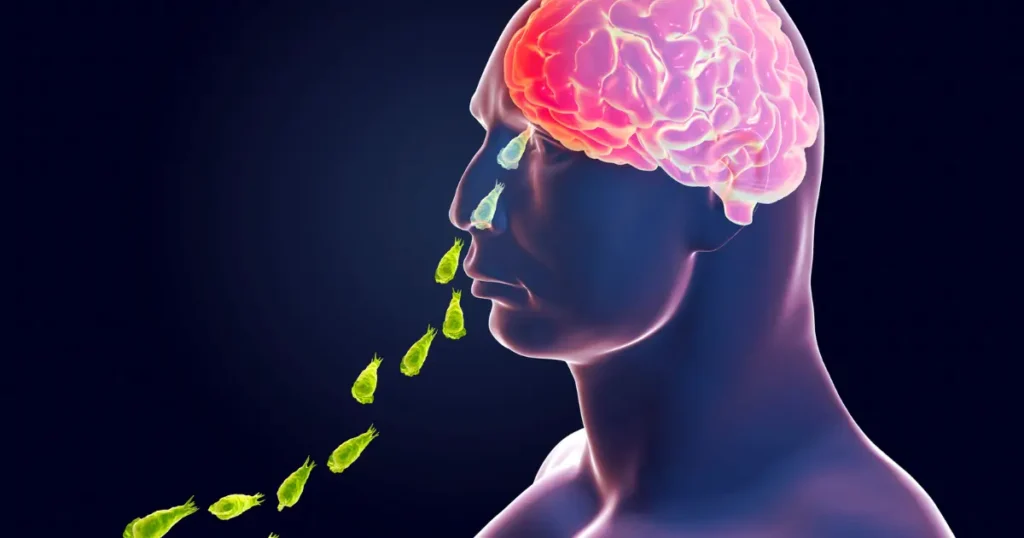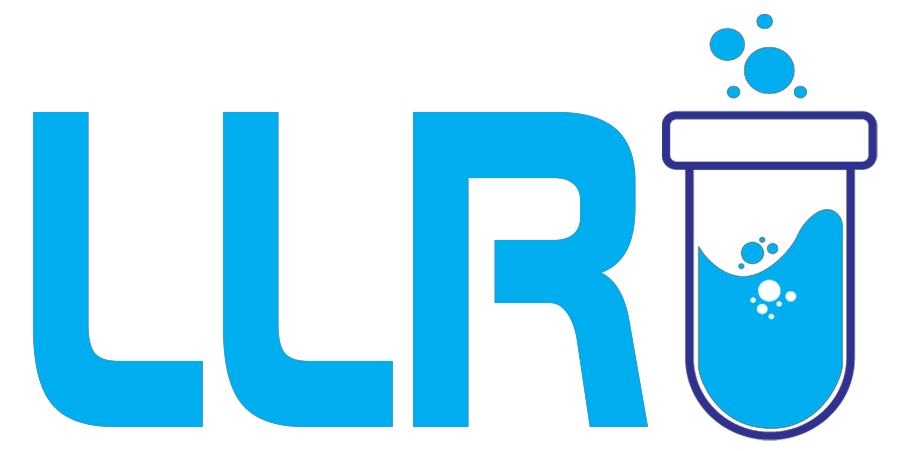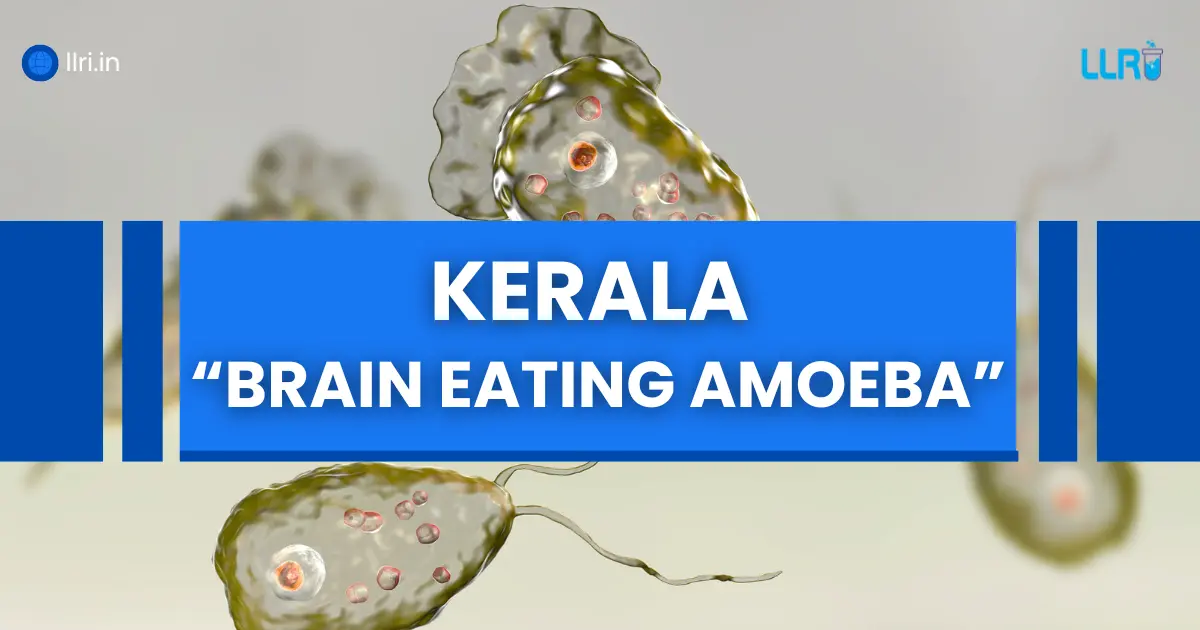Kerala Brain Eating Amoeba: It started like any normal summer day in Kerala. Children were playing by the pond, families were bathing in the river to beat the heat, and the monsoon air smelled fresh and earthy.
But within days, news spread, a teenager from Kozhikode had suddenly fallen ill after swimming. Fever, vomiting, confusion… and within a week, she was gone. Doctors confirmed the cause – the Kerala brain eating amoeba.
This tragic story is not an isolated one. In 2025, Kerala is facing a frightening outbreak of Primary Amoebic Meningoencephalitis (PAM), caused by the Naegleria fowleri, commonly known as the brain eating amoeba. By late September, the state had reported around 69 cases and 19 deaths, making it one of the most severe public health alerts Kerala has seen in recent years, as per reports by the Times of India.
But what exactly is this so-called brain eating amoeba? How does it spread? And most importantly, can it be prevented? Let’s understand the facts behind the headlines and learn how to stay safe.
What Is This “Kerala Brain Eating Amoeba”?
When people ask what is brain eating amoeba, the answer is simple yet terrifying: it’s Naegleria fowleri, a microscopic amoeba that lives in warm freshwater and can infect the human brain. In our context, when we say Kerala brain eating amoeba, we refer to the same organism now being detected in many parts of Kerala. This pathogen causes a disease called Primary Amoebic Meningoencephalitis (PAM), which is almost always fatal if not caught early.
This year, Kerala has recorded about 69 cases and 19 deaths by late September 2025, numbers that are deeply alarming and demand our attention. What’s worse, these are isolated cases, not necessarily linked to one lake, pond, or water supply, which makes epidemiological tracking more difficult.

Why Kerala’s Situation Is So Serious?
For years, Kerala has had sporadic cases of brain eating amoeba in India, mostly confined to certain districts. But in 2025, health officials observed something new, the infections are scattered across different regions, with no common water source.
Experts suggest a combination of factors:
- Rising temperatures that create ideal breeding conditions in stagnant water.
- Unmaintained ponds and wells used for bathing.
- Limited public awareness about how to avoid brain eating amoeba exposure.
Despite these challenges, Kerala’s survival rate has improved thanks to early diagnosis, better laboratory facilities (like PCR testing), and the use of miltefosine, a drug known to fight the amoeba.
How the Amoeba Spreads?
When discussing where do brain eating amoebas live, scientists say they thrive in warm, stagnant freshwater, ponds, lakes, unchlorinated pools, or poorly maintained water storage systems.
However, drinking contaminated water does not cause infection. The amoeba enters the brain through the nose, usually when people swim, dive, or bathe in infected water. That’s why experts are warning about brain eating amoeba in swimming pools that are not properly cleaned or chlorinated. Once inside, it travels up the olfactory nerves to the brain, causing inflammation and tissue damage that often leads to death within a week.
What Are the Symptoms of a Brain Eating Amoeba Infection?
One of the scariest things about brain eating amoeba symptoms is their rapid progression.
Here’s a rough timeline:
| Stages | Symptoms | What Happens |
| Early | Fever, severe headache, nausea, vomiting | Looks like common viral illness |
| Mid | Stiff neck, confusion, seizures | Indicates brain involvement |
| Late | Coma, respiratory failure, death | Rapid deterioration |
So, if you ask, what is brain eating amoeba infection like, it starts like a bad flu but quickly escalates into fatal brain swelling. The symptoms often begin 1 to 9 days after exposure, and once they set in, death usually follows within a week if untreated.
Recognizing brain eating amoeba symptoms early can be life-saving. The infection progresses rapidly, so time is crucial.
Early symptoms (within 1–9 days):
- Fever
- Headache
- Nausea and vomiting
Later symptoms:
- Stiff neck
- Confusion or seizures
- Loss of balance or hallucinations
- Coma, and eventually, death
If you or anyone around you experiences these symptoms after swimming or bathing in freshwater, seek medical help immediately. It could be a case of brain eating amoeba infection.

Why Kerala Is Facing a Crisis Now in 2025?
In previous years, cases in Kerala tended to cluster around one lake or reservoir, making tracking and containment somewhat possible. But in 2025, infections are isolated, scattered across districts, not tied to the same water source. That makes it tough to pinpoint and treat.
Additionally:
- Increased temperature and monsoon impacts may worsen conditions in water bodies.
- Many small ponds, wells, or local bathing spots are not regularly disinfected.
- Public awareness about how to avoid brain eating amoeba is still limited in rural and semi-urban areas.
- Kerala’s promising news: survival rate is improving, thanks to earlier diagnosis and the use of miltefosine (an amoebicidal drug), combined with better intensive care.
Health authorities are actively educating people about brain eating amoeba in India and especially focusing on high-risk zones in the state.
What Is Being Done by the Government?
Medical & Surveillance Measures
- Kerala has improved detection by enabling PCR and other advanced microbiology tests in regional labs.
- Treatment protocols now include miltefosine plus aggressive anti-swelling, supportive treatments.
- The state is broadcasting public awareness, issuing bulletins, and cautioning local bodies about maintaining reservoirs and public pools.
Public & Personal Precautions
Here are steps you can take to reduce risk (i.e. how to avoid brain eating amoeba):
- Avoid letting water enter your nose: Use nose clips or hold your nose when swimming or in natural water bodies.
- Use safe water for any nasal hygiene: If you do nasal rinsing (e.g. neti pot), use boiled, filtered, or properly chlorinated water, never use untreated tap or pond water.
- Avoid stagnant, warm bodies of water: Steer away from ponds, pools, lakes, slow-flowing rivers, especially during hot months when the amoeba thrives.
- Ensure proper pool maintenance: If you use a public or private swimming pool, check that chlorine levels are adequate. This addresses the concern of brain eating amoeba in swimming pools.
- Public hygiene: Municipal bodies and local self-governments need to monitor and disinfect water sources.
- Immediate action upon symptoms: Anyone who has been exposed to warm freshwater and develops fever, headache, stiffness, nausea or confusion should see a doctor without delay.
By following these steps, you reduce your personal risk of a brain eating amoeba infection, though no method is absolutely foolproof given how aggressive this amoeba is.
Read More: What is Nervous System? Types, Functions, and Disorders
How to Avoid Brain Eating Amoeba Infection?
Here are some practical steps for families to stay safe and lower the risk of Kerala brain eating amoeba infection:
- Avoid letting water enter your nose during swimming or bathing in ponds, lakes, or unchlorinated pools.
- Use nose clips, especially for children or frequent swimmers.
- Use boiled or filtered water for nasal hygiene or religious rituals.
- Avoid stagnant, warm water after heavy rains or heatwaves.
- Keep swimming pools clean, proper chlorination kills Naegleria fowleri.
- Seek medical help immediately if anyone shows brain eating amoeba symptoms after water exposure.
These simple habits can make a big difference.

On A Final Note…
The word “brain eating amoeba” sounds like something from science-fiction, but in Kerala, it’s a grim reality. Yet, even within this crisis, stories of survival are emerging. Because Kerala brain eating amoeba cases are now being caught earlier, more patients are being given miltefosine and supportive care, and the survival rate is inching higher than before.
We have a long road ahead, scientists, doctors, and citizens must work together. Local people should be alert to brain eating amoeba symptoms, understand how to avoid brain eating amoeba, and demand clean, safe water sources. Public health teams must map brain eating amoeba in India and in Kerala, monitor where do brain eating amoebas live, and ensure safe swimming pools that don’t harbor this pathogen.
If you live in or are visiting Kerala, take this seriously. Spread the word to your family, friends, and neighbours. Ask local authorities about water safety in your area. One day, that alert might help someone’s life.

